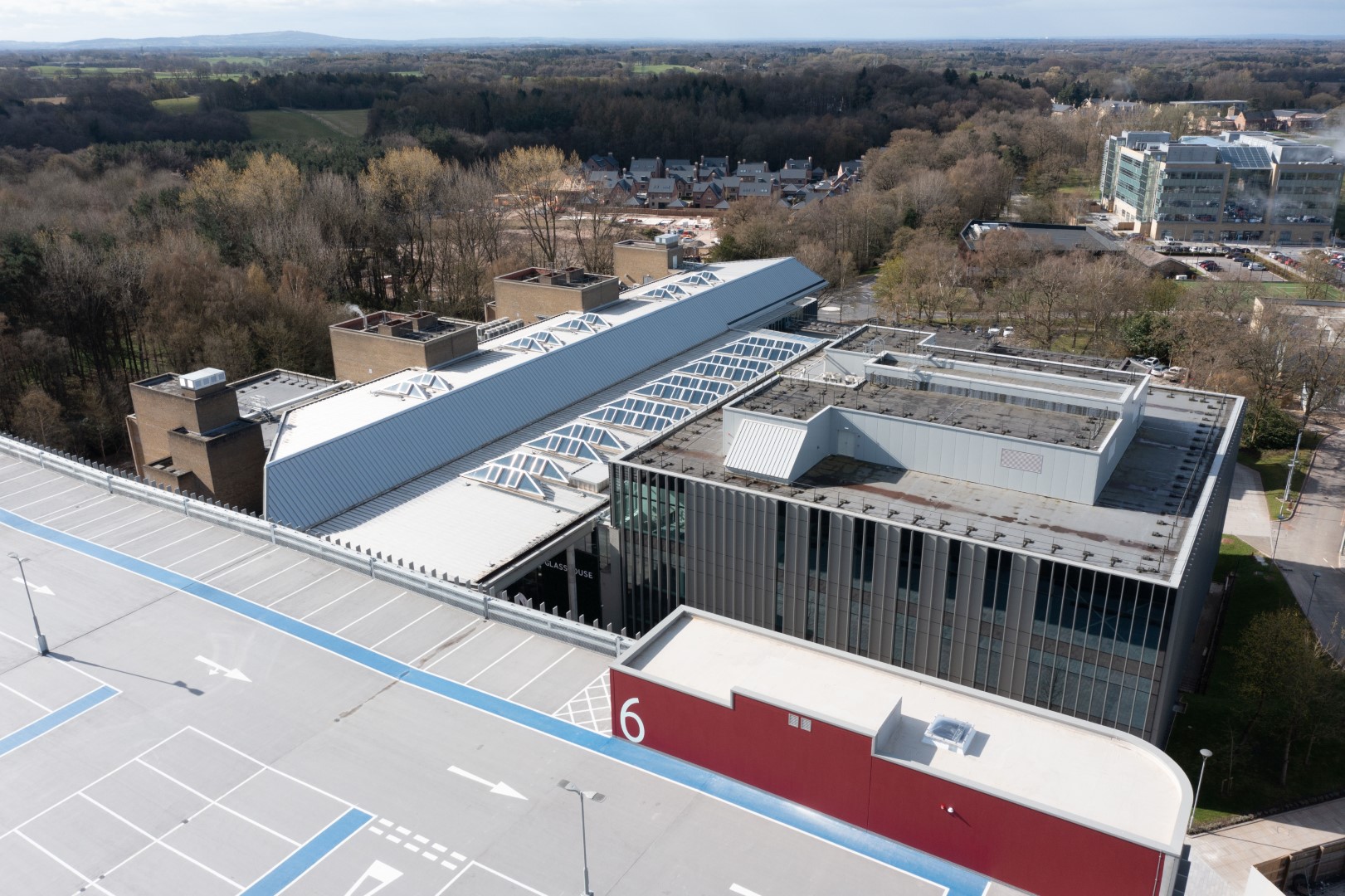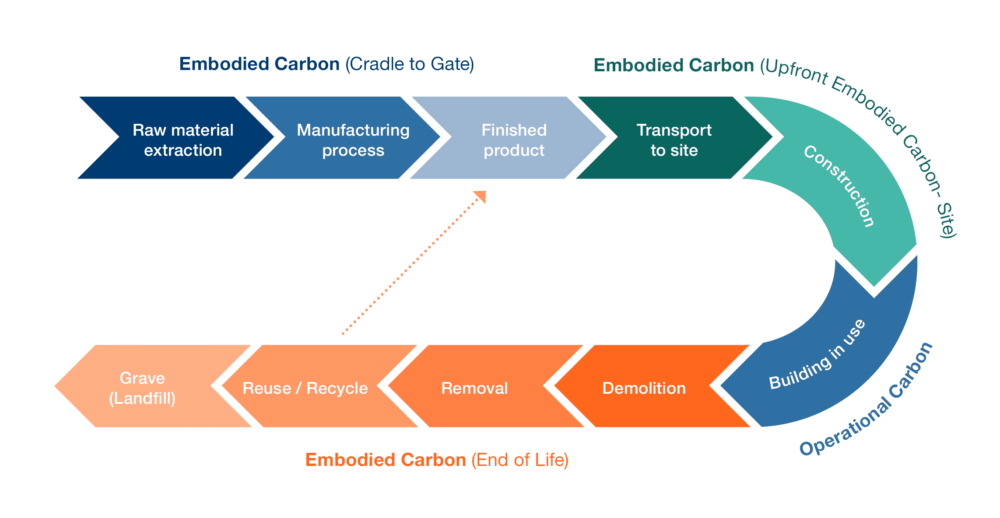

Key decisions made at the earliest stages of your roofing project can reduce both embodied and operational carbon, resulting in a significant reduction in whole-life carbon output for your building. We’ll explore current building requirements, how carbon emissions occur within the construction, and how Garland UK can help you on the journey to carbon reduction through your roofing project.
Carbon Reduction and Building Regulations
Currently, carbon emissions from buildings and construction account for almost 40% of the UK’s total carbon emissions and up to 11% of total global emissions. On 27 June 2019, the UK became the first major economy to pass laws to end its contribution to global warming, committing to a 78% cut in carbon emissions by 2035 and to become net zero by 2050.
The building industry is working closely with the government to help to achieve these targets. This has resulted in major changes to the Building Regulations, which have now come into effect as of 15 June 2022, notably Part L (fuel and power), Part F (ventilation) and the introduction of a new Approved Document O which deals with mitigating overheating in buildings. These changes now require non-domestic buildings to achieve an average of 27% reduction relative to 2013 regulations, whilst domestic buildings must achieve a 30% reduction. This is just the start, as the Future Homes and Buildings Standard will be introduced in 2025, aiming to ensure that new construction produces around 75% less carbon emissions relative to 2013 regulations.
Of course, it is not only legislation that is driving change. There has been a significant shift in how proactive companies themselves are in adopting environmental and sustainable change. Before, the conversation was often led by budget, but increasingly long-term sustainable targets are of paramount importance to clients. Many businesses have set their own company-wide environmental goals, and construction can play a major role in helping to achieve these aims.
Roofing projects can become vital in addressing these challenges and meeting your sustainability objectives by taking a more holistic approach to the issue and becoming more informed on the potential sources of carbon emissions.
Embodied Carbon
Embodied Carbon refers to the CO2 emitted in producing physical materials associated with building construction. This includes the extraction and refinement of raw materials, the manufacturing of products from those materials, transport, the construction of the structure, and the deconstruction and disposal of materials at the end of life. It can be considered the carbon footprint of construction materials.
In relation to your roofing project, the best way to improve the Embodied Carbon output (and overall carbon reduction) of a roof is to increase the length of time that it is useable, so the longer the life-cycle of your chosen roofing solution, the greater the improvement in its embodied carbon emissions. You can read more on Roof Life Cycle Costing here.
Buildings are typically designed to last 60 years, so it is essential to look ahead and choose a roofing solution that utilises products that can get as close to this benchmark as possible.
A longer life cycle provides additional benefits, reducing capital expenditure and allowing for better budgetary planning by minimising future refurbishment or replacement needs.
Taking into account the life cycle of the products used on a project, and therefore the reduced Embodied Carbon, is also an intrinsic part of a BREEAM evaluation, where Life Cycle Costing is utilised to assess the sustainability of a project providing for up to 4 credits.
Operational Carbon
Operational Carbon refers to the total carbon emitted from all energy sources used to keep a building warm, cool, ventilated, lighted and powered.
Both new build and refurbishment roofing works provide a real opportunity to drastically reduce Operation Carbon outputs. By constructing a roof that is well insulated (building regulations require that all non-dwelling warm low-slope and pitched roofs must achieve a U-value of 0.18 W/m2K), not only is the thermal efficiency of the roof improved, this in turn, has the added benefit of improving the energy efficiency of the building as a whole, reducing both the heating and cooling needs within. Not only does this reduce the Operational Carbon output, but it also has the added benefit of reducing the daily operational running costs of the building.
Further improvements in energy efficiency can be provided through the increased use of rooflights to provide more natural daylight and reduce lighting needs, as well as the installation of Photovoltaic Solar Panels. We discuss in more detail the advantages of solar for commercial landlords here.
Green roofing should be considered to help carbon reduction and, in particular, reduce Operational Carbon even further. Green roofs not only improve a roof’s thermal performance and energy efficiency, but they also capture carbon dioxide through the plants that they incorporate and help with urban cooling through evapotranspiration. A study by Kurunoma et al. 2018 concluded that an extensive green roof has an approximate carbon payback time of between 6.4-15.9 years. In addition, properly maintained Green Roofs have an exceptionally long lifespan, further helping to reduce Embodied Carbon.

Whole Life Carbon
Taking both Embodied Carbon and Operational Carbon into account is essential. Together they provide the Whole Life Carbon of a building, which Garland UK always takes into consideration to provide the most sustainable choices for our client projects. We believe in partnering with you for the life of your building to provide for the long-term health of your building.
Taking a whole life carbon approach to carbon reduction will help to guide the big decisions, which in many cases can be whether to completely remove a roof and start again, or refurbish the existing system. We employ a Cradle to Cradle ethos, meaning at the end of the lifespan of your roof, we will always first endeavour to refurbish where possible, reuse what we can and finally recycle anything that cannot be reused.
The use of innovative materials and construction methods help to support this goal. Our Metal Roofing Systems for example, are 100% recyclable. Recycled metals can save as much as 90% of the Embodied Carbon compared to processing from metal ore. We only replace what is necessary to ensure the best performance for your roof.
Products such as R-MER CLAD allow for a new roofing system to be installed, whilst leaving the existing roof in place, mitigating waste that has to go to landfill in the process, not to mention saving you additional costs.

“Your roof can play a major part in reducing your buildings carbon output helping to meet government requirements and improve the sustainability of your building as a whole.”
Justyn Irons, Technical Manager, Garland UK
